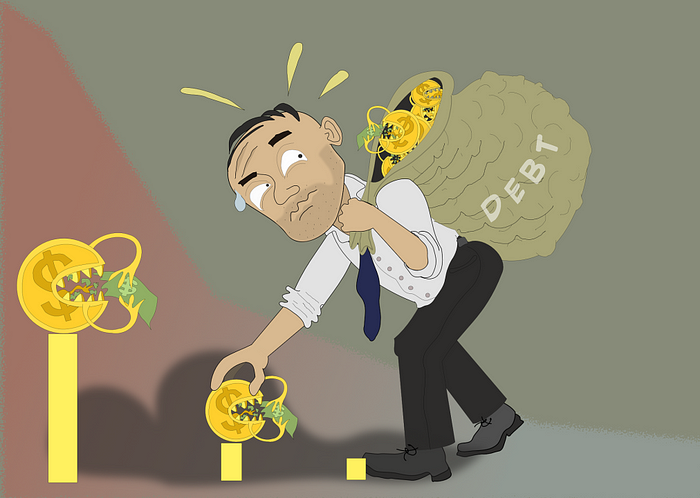Today, I want to talk about one of the most misunderstood yet essential tools for building wealth: debt. Over the past 200 years, debt has played a pivotal role in shaping economies, funding wars, and creating opportunities for individuals and nations alike. Yet, while many fear it, the rich have mastered the art of using debt as a lever to multiply their wealth. Let’s dive into the fascinating history of debt and explore why it’s not only necessary but also a powerful tool if you want to get rich.
A Brief History of Debt
Debt has been around as long as money itself. For the United States, it began with the Revolutionary War, which left the country with $75 million in debt by 1791. Over time, public debt grew as the government financed wars, infrastructure projects, and economic crises:
- 1835: Under President Andrew Jackson, the U.S. paid off its national debt entirely for the first and only time. But this didn’t last — by 1846, new wars and expansion projects brought debt back into play.
- 1860s: The Civil War caused U.S. debt to skyrocket from $65 million to $2.7 billion by 1865.
- World Wars: Debt ballooned again during World War I ($22 billion) and World War II ($260 billion).
- 1980s: The U.S. entered a new era of borrowing, tripling its national debt within a decade to fund military buildups and social programs.
Debt is not just an American story — it’s global. Nations have borrowed to fund wars, industrial revolutions, and economic recoveries. And while defaults have occurred (Greece famously defaulted multiple times in the 19th century), borrowing has been essential for growth.
Why Debt Is Necessary for Wealth
Here’s a truth that might surprise you: you can’t get rich without understanding how to use debt effectively. While most people see debt as something to avoid, the wealthy embrace it as a tool for leverage. Why? Because debt allows you to control assets far larger than your own capital would permit.
Let me break it down with an example:
Imagine you want to buy a $1 million property. If you pay cash, you’ve tied up all your money in one asset. But if you use $200,000 as a down payment and borrow the remaining $800,000 at a low interest rate, you now control a $1 million asset while keeping $800,000 available for other investments. Over time, as the property appreciates in value (say it grows to $1.5 million), your return on investment is far greater than if you had paid cash.
This is called leverage, and it’s how the rich multiply their wealth.
How the Rich Use Debt to Build Wealth
The wealthy don’t fear debt — they wield it strategically across multiple areas:
1. Real Estate
Real estate is one of the most common ways the rich use debt to build wealth. By taking out mortgages or loans, they acquire appreciating assets while generating cash flow through rents. Here’s how it works:
- A wealthy investor buys a $10 million property with $2 million down and an $8 million loan.
- Over time, rents increase while the property appreciates in value.
- The investor uses this growing equity to take out additional loans and buy more properties.
This compounding effect allows them to build massive real estate portfolios without tying up all their personal capital.
2. Business Expansion
Debt is also critical for scaling businesses. Companies like Amazon relied heavily on loans in their early years to build infrastructure and expand operations quickly. By borrowing money at low interest rates and reinvesting it into high-growth opportunities, businesses can grow far faster than relying solely on profits.
3. Leveraged Buyouts (LBOs)
Private equity firms often use debt to acquire companies without risking much of their own money. They borrow funds using the acquired company’s assets as collateral, improve its profitability, and either sell it or keep collecting returns while paying down the loan.
The Compounding Power of Leverage
Here’s where things get really interesting: when used wisely, debt doesn’t just help you acquire assets — it can create exponential growth over time.
Let’s say you borrow $500,000 at 5% interest to invest in an asset that generates a 10% return annually:
- In Year 1, you earn $50,000 on your investment but only pay $25,000 in interest — a net gain of $25,000.
- Over 10 years, assuming compounding growth, your asset could double in value while your loan remains fixed.
This is how billionaires like Donald Trump built their empires — by using borrowed money to control appreciating assets while keeping their own capital free for other opportunities.
Debt Is Not Without Risks
Of course, not all debt is good debt. The key difference between how the rich use debt and how most people misuse it lies in cash flow. The wealthy only take on debt that will generate income or appreciate over time — like real estate or business investments — not liabilities like cars or vacations.
For example:
- A rental property generates monthly income that covers its mortgage payments.
- A business loan funds expansion that increases revenue enough to repay the loan with profit left over.
In contrast, borrowing for non-productive purposes (like consumer goods) often leads to financial stress rather than wealth creation.
Final Thoughts: Debt Is Your Ally
Debt has been a driving force behind economic growth for centuries — and it can be your ally too if used wisely. The key is understanding when and how to leverage borrowed money:
- Invest in assets that generate income or appreciate over time.
- Ensure your cash flow can cover your borrowing costs comfortably.
- Use leverage strategically to multiply your returns without overextending yourself.
As history shows us — from nations financing wars to entrepreneurs building empires — debt is not something to fear but something to master. The rich understand this better than anyone else: they don’t just work hard; they let their money (and other people’s money) work hard for them.
As Naval Ravikant once said:
“You’re not going to get rich renting out your time — you must own equity or leverage.”
Maybe it’s time we stop fearing debt and start using it like the wealthy do — to build lasting wealth and financial freedom for generations to come.
Thanks for reading! If you want to stay up to date with our portfolio and get exclusive insights into the markets, sign up for our newsletter. We provide in-depth analysis of market trends and share our latest investment strategies. As a subscriber, you’ll also receive our latest predictions and be the first to know about any changes we make to our portfolio.
Don’t miss out on this opportunity to learn from our experience and build a stronger portfolio for yourself. Sign up today and join our community of savvy investors.
And if you appreciate our content and want to support our work, consider becoming a Medium member. For just $5 a month, you’ll get unlimited access to the best articles on Medium, including our latest research and analysis.
Please note that while we strive to provide accurate and helpful information, this article is for informational purposes only and should not be construed as financial or legal advice. Always consult with a professional advisor before making any investment decisions.

